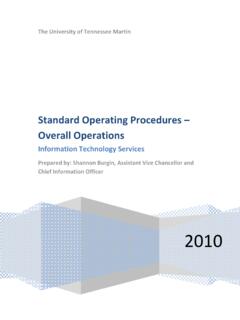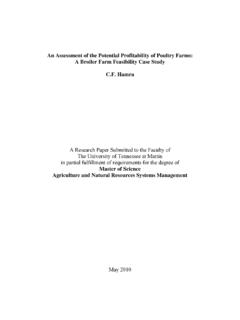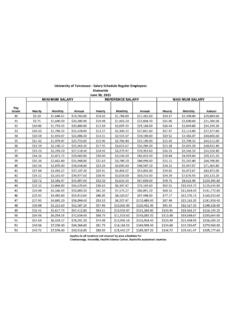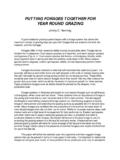Transcription of Stockpiling Forage Grasses for Winter Grazing in …
1 Stockpiling Forage Grasses for Winter Grazing in West Tennessee A Research Paper Submitted to the Faculty of the University of Tennessee at Martin Fulfilling Requirements for the Degree of Master of Science in Agricultural Operations Management Submitted by: Justin D. Pope May 2011 ii ACKNOWLEDGEMENTS I would like to express my gratitude to all those who helped me during this time of study and research in the MSAOM program. I would like to thank Dr. Richard Joost, for his guidance, planning, direction and data collection for my research. I would also like to thank Dr. Barbara Darroch for helping me analyze my data, compile this paper, and for providing motivation to finish my degree. To everyone who had a part in the completion of this project, I want to sincerely express my appreciation.
2 Iii ABSTRACT With beef cattle producers looking for an alternative to traditional Forage systems of feeding stored hay and silage in the Winter months, Stockpiling forages has become of interest. Stockpiling is the agricultural practice of maintaining pastureland throughout all seasons, including hot and dry periods of weather that greatly increase the percentage of dormancy in Grasses . This is done by removing cattle from pasture in late summer and allowing the grass to grow for the cattle to graze in the late fall and Winter . The species of grass in Stockpiling is an important factor. Adequate rainfall and moisture in the late summer and autumn is also very important. An application of nitrogen fertilizer in the late summer can also increase yield potential of the grass.
3 A field study was initiated in August of 2006 to evaluate the effects of nitrogen fertilizer rate and different harvest dates on Forage yield and percent moisture of stockpiled tall fescue (Lolium arundinaceum), orchard grass (Dactylis glomerata), and Bermudagrass (Cynodon dactylon (L)). In another trial, three varieties of tall fescue, Kentucky 31, Max-Q, And Triumph, were compared. For each of the species trials, a split-plot design with four replicates was used. Harvest date was the main plot and nitrogen rate was the sub-plot factor. Nitrogen fertilizer was applied at four rates (0, 45, 90, and 135 kg/ha) and the Forage was harvested in December, January and February. The tall fescue variety study was arranged in a split-split plot design with four replicates.
4 Three nitrogen fertilizer rates (45, 90, and 135 kg/ha) and two harvest dates (December and January) were used. iv There was no significant (P< ) difference in percent moisture among harvest dates for Bermuda and orchard grass. However, for the fescue trial in 2006 and 2007, percent moisture was significantly (P< ) greater in January and February than in December. For the Bermudagrass experiment, there was no significant (P< ) difference in percent moisture among nitrogen fertilizer rates. In orchard grass and tall fescue, there were significant (P ) linear contrasts for percent moisture of the Forage in response to nitrogen fertilizer rate. In the tall fescue variety trial there was no significant difference in percent moisture among varieties. However, percent moisture of the Forage was significantly (P< ) greater in January than in December.
5 Fertilizer also had a significant linear (P< ) effect on percent moisture of the tall fescue Forage in the variety trial. Forage yield decreased (P< ) after January in the Bermudagrass and tall fescue trials. However, the yield of the orchard grass Forage was significantly (P< ) greater in January than in December or February. There was a significant (P ) linear contrast for yield in response to nitrogen fertilizer rate for all species. There was no significant (P< ) difference in yield among the different varieties in the fescue variety trial. In the fescue variety trial, Forage yield was significantly (P< ) greater in December than in January. In addition, Forage yield increased (P< ) as nitrogen fertilizer rate increased. Stockpiling forages can be a useful tool for beef cattle producers.
6 Depending on the amount of rainfall received and the species grass used an application of nitrogen fertilizer can increase Forage yield. This study has shown that forages need to be v harvested by January to maximize yield and get maximum benefit from the stockpiled grass. vi TABLE OF CONTENTS Title Page Chapter I Introduction .. 1 Objectives .. 1 Chapter II Literature Review .. 2 Economic Value .. 2 Fertilizer Application .. 4 Managing Stockpiled Forage .. 5 Tall Fescue .. 7 Orchard Grass .. 9 Bermudagrass .. 10 Chapter III Materials and Methods .. 13 Plot Design .. 13 Experimental Setup .. 13 Data Collection.
7 18 Statistical Analysis .. 19 Chapter IV Results and Discussion .. 20 Percent Moisture .. 20 Yield .. 25 Chapter V Conclusion .. 33 Literature Cited .. 34 Appendix .. 38 vii LIST OF TABLES Table Page Table 1. Percent Moisture response to harvest date and four rates of fertilizer application in 2006 and 2007 .. 22 Table 2. Effect of variety, harvest date, and nitrogen fertilizer rate on percent moisture .. 26 Table 3. Yield (kg/ha) response to harvest date and four rates of fertilizer application in 2006 and 2007 .. 28 viii LIST OF FIGURES Figure Page Figure 1. Plot field plan for orchard grass research plots.. 14 Figure 2. Plot field plan for Bermudagrass research 15 Figure 3.
8 Plot field plan for tall fescue research plots.. 16 Figure 4. Plot field plan for tall fescue variety plots.. 17 Figure 5. Monthly precipitation totals recorded in Martin, TN during experiment.. 21 Figure 6. Effect of harvest date on percent moisture of stockpiled Bermudagrass, tall fescue and orchard grass grown in Martin, TN in 2006 and 2007.. 23 Figure 7. Effect of nitrogen fertilizer rate on percent moisture of stockpiled Bermudagrass, tall fescue, and orchard grass grown in Martin, TN in 2006 and 2007.. 24 Figure 8. Effect of nitrogen fertilizer rate on % moisture of three tall fescue varieties grown in Martin, TN in 2006 and 2007.. 27 Figure 9. Effect of nitrogen fertilizer rate and harvest date on Forage yield of Grasses grown in Martin, TN in 2006 and 2007.
9 29 Figure 10. Effect of nitrogen fertilizer rate and harvest date of Grasses grown in Martin, TN in 2006 and 2007.. 31 Figure 11. Effect of nitrogen fertilizer rate on tall fescue grown in Martin, TN in 2006 and 2007.. 32 1 CHAPTER I - Introduction Stockpiling is the agricultural practice of maintaining pastureland throughout all seasons, including Stockpiling for Winter Grazing as well as for hot and dry periods of weather that greatly increase the percentage of dormancy in Grasses . The innovative practice of Stockpiling is more efficient than the traditional practice of conserving hay and silage for the Winter months. The traditional method of conserving hay and silage has a much higher maintenance requirement than Stockpiling . The long-established practice of conserving hay and silage requires a greater amount of physical labor, heavier use of associated machinery, and the inconvenience of maintaining storage and feeding facilities.
10 Stockpiling forages for beef cattle production is an area that needs further research in northwest Tennessee. Objectives The objectives of this study were to: 1. Determine the effect of nitrogen application rate (0, 40, 80, or 120 lbs/ac), on Forage yield and percent moisture in Bermudagrass, tall fescue, and orchard grass. 2. Determine if timing of harvest has an effect on Forage yield and percent moisture in Bermudagrass, tall fescue, and orchard grass. 3. Evaluate three cultivars of tall fescue (Ky 31, Triumph, or MaxQ) to determine the impact of Forage yield and percent moisture. 2 CHAPTER II - Literature Review The system of Stockpiling autumn sowed pastures can prove to be a valuable practice in Forage production. By Stockpiling tall fescue pasture for fall and Winter Grazing by beef cows, it is possible to provide a sizeable amount of high quality Forage , while increasing economic returns (Allen et al.)









